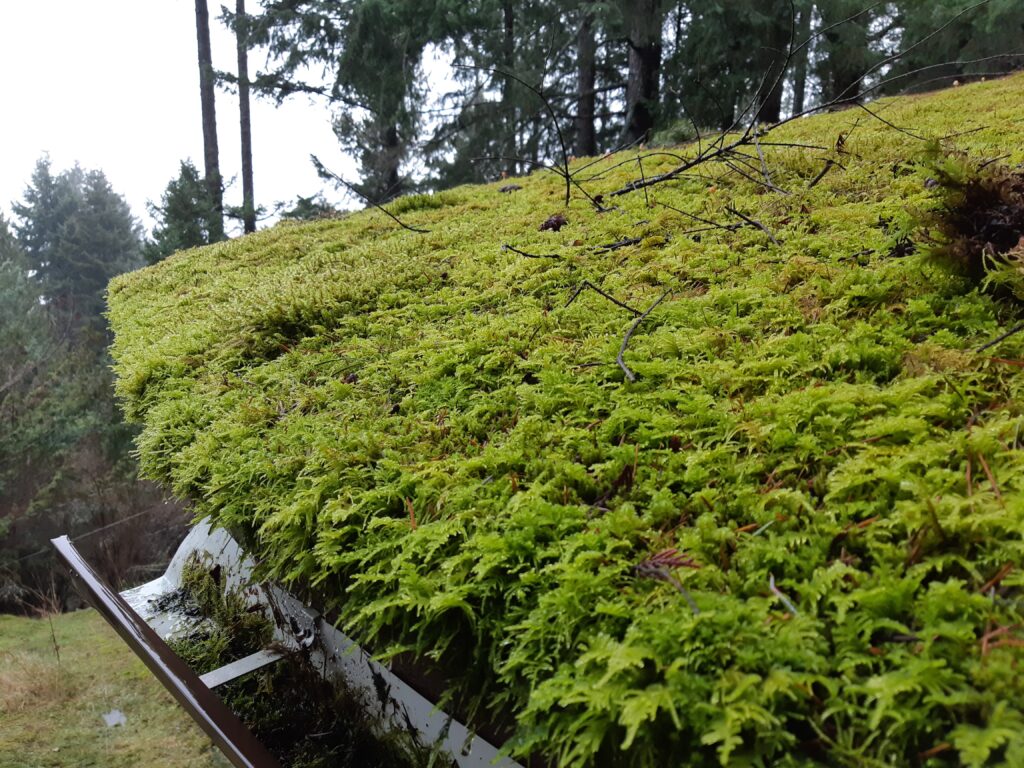- Photo: Moss growth on roof was 4 to 6 cm.
- Abstract: Bowen Island Home Inspector discusses potential risk to occupancy.
Green Roof by Default
A home inspection on the last day of 2020 presented a unique situation. The roof was completely covered in a layer of moss. This was not by design but rather due to natural circumstances. The roof had not been cleaned off from leaves or needles and over many years had developed a layer of organic material. Further, the property was located among tall trees which contributed to the situation by providing shade. It was the perfect environment to grow a moss blanket and so it did, undisturbed.
The inspector did not traverse the roof as it was unsafe to do so, without visual clues as to its condition. Our inspection was from the roof’s edge, where a small edge piece was gently lifted up. This exposed the composite shingles below. The shingles appeared to be in reasonable condition, without any root tendrils intertwined with the substrate material. Inspection of the vaulted ceiling inside showed no visual evidence of distress. Therefore the roof was performing well, even though it had never been designed as a green roof.
Looks Are Deceiving
One may get the impression that the green roof was a freebie, a result of unanticipated consequences. Others may possibly choose to follow by example of just letting their roofs ‘mature’ naturally as well. Unfortunately, since this was most definitely not a green design, other traditional building components have suffered as a result of their proximity to and interdependance with the roof.
The wooden soffit panels and facia boards were attacked mercilessly by the continuously wet conditions of the living roof. Rot, to the point of breaking through and creating large holes, in the soffit were prevelant and widespread. This resulted in open access to the attic cavity for weather, birds, insects, sqirrels, bats… without a barrier. These building elements will now have to be replaced immediately. Since damaged soffits also expose the roof sheathing to attack, that too will need replacing at the same time.
So the take-away is that unless all the building envelope systems are designed together to accomodate a green roof, just because one item has chosen to do so does not mean the other components can handle that particular condition.
Major Structural Issue for Roof
As a professional engineer the inspector was curious to know if a conventional roof design could handle this accumulated load of moss growth, without deflection, or at worst, failure (collapse). In our case the house was built in the 1960’s with a rather unconventional design… a round house with a central post to which all the roof rafters are connected.
Without any access to the original calculations we proceeded to do the following guestimate (guess estimate).
A typical building code for a roof will specify a dead load and a live load. The dead load is what the roof components themselves will weigh that the house construction (walls and foundation) must support. The live load is what the roof can support on a temporary basis. Although rather permanent, the moss loading has to be within the live load allowance.
Here’s the numbers we used in our deliberation. They are based on fairly typical values for each item. [psf = pounds per square foot]
Roof Dead Load = 15 psf
Roof Live Load = 15 psf
Moss Load = 12 to 17 psf
It appears that the weight of the moss is near, or can exceed, the design parameters.
Immediate Action Required
Although the actual moss weight per square foot may be substantially less than what values were found on the web, there is cause for concern as we have no idea what the real dead load and live load calculations were for this dwelling. It is important to add that there was no indication of water stains or sagging when the ceiling was viewed from the interior. So no apparent outward signs of distress… yet.
Nonetheless, the roof was never designed for this load. The parameter that the moss is measured against is a temporary load rating, meaning it is a weather dependent unit that changes over time, such as snow which disappears with temperature rise.
In the inspector’s opinion, there is sufficient grounds for action to be taken and immediately. The moss needs to be removed now to reduce the stress on the old roof. Both the seller’s and buyer’s agent were informed of this recommendation.

